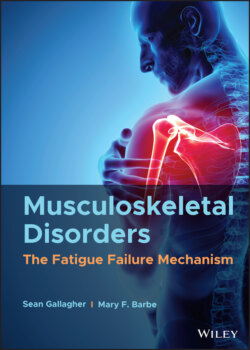Читать книгу Musculoskeletal Disorders - Sean Gallagher - Страница 83
Organization
ОглавлениеLike muscle, tendons exhibit a hierarchical bundling structure (Figure 3.13). At the smallest level, collagen molecules (tropocollagen) are bundled into collagen fibrils, which are bundled together into interdigitating collagen fibrils. These are then further bundled into primary fiber bundles (subfascicles) by an endotenon connective tissue layer. The subfascicles are bundled together into a larger fascicle that is also surrounded by endotenon. At the fascicle level, a characteristic “crimp” pattern can be seen histologically. Several fascicles are then bundled together to form the whole tendon, all of which are surrounded by an outer denser epitenon wrapping (Figures 3.12 and 3.13). This nested structure allows the bundles to slide independently from one another. As mentioned above, there are several components to the extracellular matrix of tendons that are hierarchically arranged and cross‐linked together. This highly ordered structure provides strength, durability, high tensile strength, and stability during force transmission.
Figure 3.13 Schematic depicting the hierarchical structure of tendon, with inset images: Transverse sections show fibril and fascicle packing. The longitudinal histological section (hematoxylin and eosin) shows the tendon cell populations.
Modified from: Screen, H. R., Berk, D. E., Kadler, K. E., Ramirez, F., & Young, M. F. (2015). Tendon functional extracellular matrix. Journal of Orthopaedic Research, 33(6), 793–799, First published: 30 January 2015, doi: 10.1002/jor.22818. Wiley.
At the macroscopic level, tendons are not homogeneous structures. They can be broadly divided into three regions along their axis. There is a muscle–tendon junction (the myotendinous junction), a tendon midbody, and a tendon–bone junction (the enthesis) locates where tendons attach to bone. The myotendinous junction and enthesis have distinct structural, cellular, and molecular characteristics compared to the midbody of a tendon. The myotendinous junction displays a “zipper” like morphology, where skeletal muscle fibers and tendon collagen fibrils interdigitate. At this same point, the cytoskeletal network and basement membrane of muscle fiber bundles directly attach to the collagen fibrils of tendons. Regarding entheses (Figure 3.12c), some are primarily fibrous and noncartilaginous, although most tendon–bone attachments employ fibrocartilagenous entheses. The latter consist of four zones of connective tissue, listed in order from the tendon to the bone: (a) fibrous tissue originating from tendon (the aligned collagen fibrils surrounding fibroblasts resemble the tendon midbody), (b) uncalcified fibrocartilage, (c) calcified fibrocartilage, and (d) subchondral bone. This gradual change in structure reduces mechanical stress levels between the tensile tendon and the brittle bone.
Some tendons are also enclosed by tube‐like synovial sheaths, for example, at the wrist and ankle. These sheaths are made up of two layers, both lined by flattened synovial cells of mesenchymal origin. The inner visceral layer is attached to the surface of the tendon, while the outer parietal layer is adjacent to neighboring structures. The space between these layers contains a viscous fluid similar in composition to the synovial fluid of synovial joints. This liquid is composed of water, proteins, hyaluroanate, and other glycosaminoglycans. This synovial secretion acts as a lubricant permitting easy sliding movements of a tendon within its sheath. Tendinitis or tenosynovitis is an inflammation of this tendon sheath and are painful conditions that can follow trauma, excessive strain, or excessive exercise (see Chapters 2 and 11).
Tendons have a very rich neural network and are often innervated from the muscles with which they are associated or from local nerves. There are many nerve endings at the sites of myotendinous junctions and bone–tendon junctions, including Golgi tendon organs and free nerve endings (which are typically pain fibers), as discussed further in Chapter 4. With regard to vascularization, the interior of healthy tendons is fairly devoid of blood vessels, with most of the blood vessels localized to the tendon sheaths.
